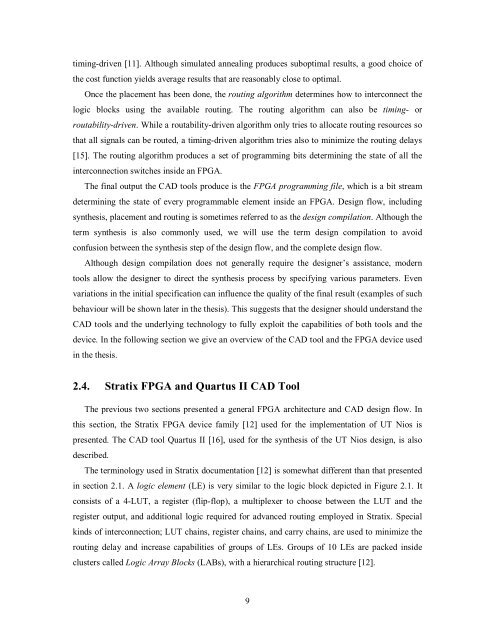Soft-Core Processor Design - CiteSeer
Soft-Core Processor Design - CiteSeer
Soft-Core Processor Design - CiteSeer
Create successful ePaper yourself
Turn your PDF publications into a flip-book with our unique Google optimized e-Paper software.
timing-driven [11]. Although simulated annealing produces suboptimal results, a good choice of<br />
the cost function yields average results that are reasonably close to optimal.<br />
Once the placement has been done, the routing algorithm determines how to interconnect the<br />
logic blocks using the available routing. The routing algorithm can also be timing- or<br />
routability-driven. While a routability-driven algorithm only tries to allocate routing resources so<br />
that all signals can be routed, a timing-driven algorithm tries also to minimize the routing delays<br />
[15]. The routing algorithm produces a set of programming bits determining the state of all the<br />
interconnection switches inside an FPGA.<br />
The final output the CAD tools produce is the FPGA programming file, which is a bit stream<br />
determining the state of every programmable element inside an FPGA. <strong>Design</strong> flow, including<br />
synthesis, placement and routing is sometimes referred to as the design compilation. Although the<br />
term synthesis is also commonly used, we will use the term design compilation to avoid<br />
confusion between the synthesis step of the design flow, and the complete design flow.<br />
Although design compilation does not generally require the designer’s assistance, modern<br />
tools allow the designer to direct the synthesis process by specifying various parameters. Even<br />
variations in the initial specification can influence the quality of the final result (examples of such<br />
behaviour will be shown later in the thesis). This suggests that the designer should understand the<br />
CAD tools and the underlying technology to fully exploit the capabilities of both tools and the<br />
device. In the following section we give an overview of the CAD tool and the FPGA device used<br />
in the thesis.<br />
2.4. Stratix FPGA and Quartus II CAD Tool<br />
The previous two sections presented a general FPGA architecture and CAD design flow. In<br />
this section, the Stratix FPGA device family [12] used for the implementation of UT Nios is<br />
presented. The CAD tool Quartus II [16], used for the synthesis of the UT Nios design, is also<br />
described.<br />
The terminology used in Stratix documentation [12] is somewhat different than that presented<br />
in section 2.1. A logic element (LE) is very similar to the logic block depicted in Figure 2.1. It<br />
consists of a 4-LUT, a register (flip-flop), a multiplexer to choose between the LUT and the<br />
register output, and additional logic required for advanced routing employed in Stratix. Special<br />
kinds of interconnection; LUT chains, register chains, and carry chains, are used to minimize the<br />
routing delay and increase capabilities of groups of LEs. Groups of 10 LEs are packed inside<br />
clusters called Logic Array Blocks (LABs), with a hierarchical routing structure [12].<br />
9














